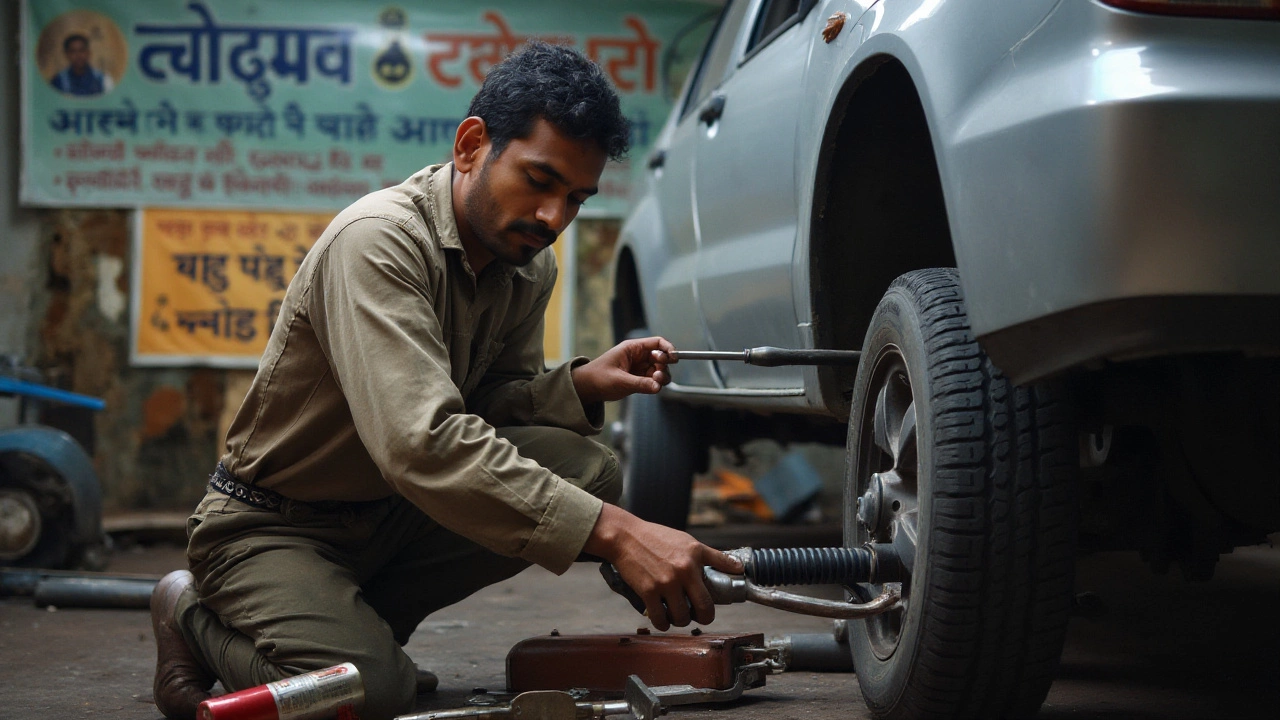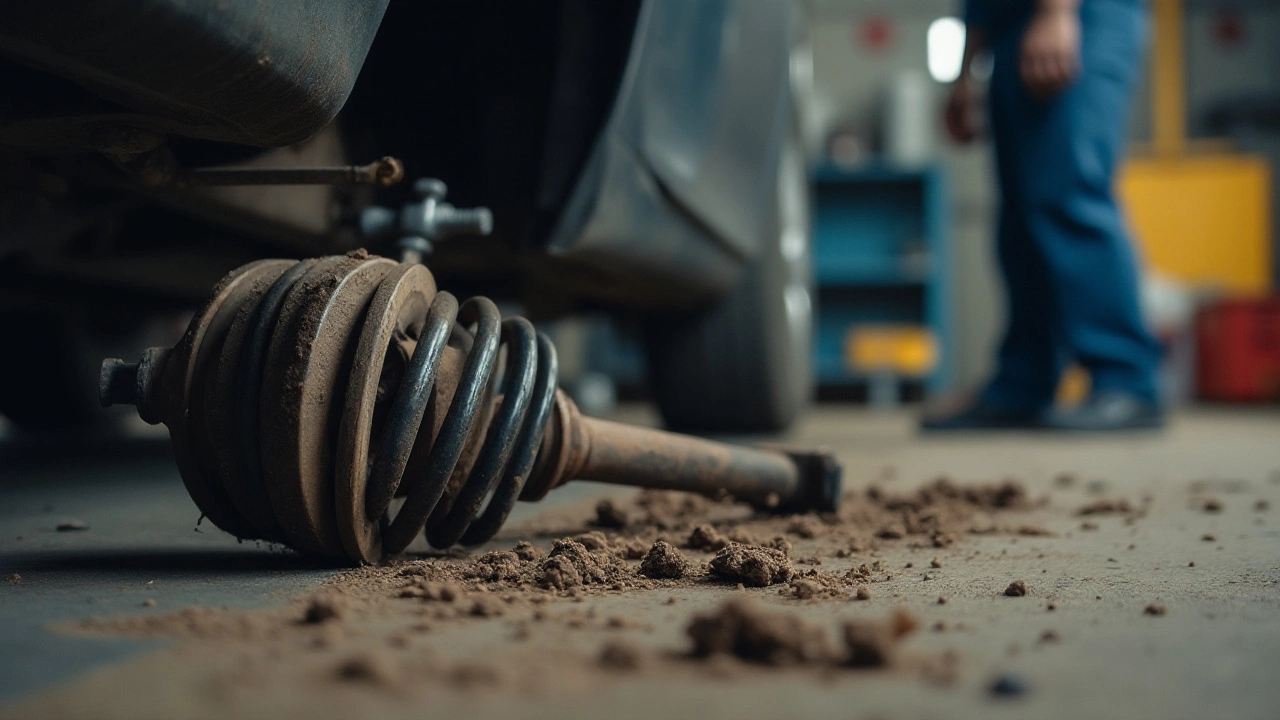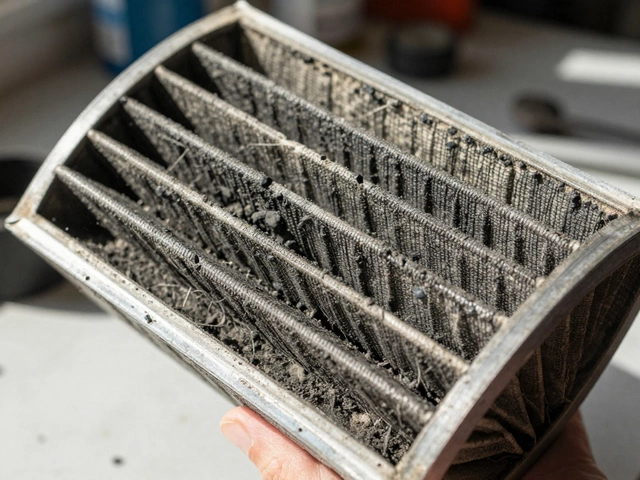
The suspension system in your car plays an essential role in ensuring a smooth and controlled driving experience. If it suddenly seems like you're feeling every bump in the road or catching an unusual bounce, your suspension might be calling for attention. A defective suspension not only affects your car's comfort but can also drive straight towards safety hazards.
Handling a bad suspension can seem daunting, but diving into this article might help alleviate some of that stress. We’ll explore what a suspension system does, common problems it faces, and how to recognize when something’s amiss. More importantly, consider whether these problems can be fixed and whether you should handle them yourself or call in the cavalry—a professional mechanic.
- Understanding Car Suspension
- Common Suspension Issues
- Symptoms of a Bad Suspension
- Can It Be Fixed?
- DIY vs Professional Repair
- Preventing Future Suspension Damage
Understanding Car Suspension
Your car's suspension system is more than a series of springs and shock absorbers; it's a complex, yet cleverly engineered network designed to provide stability and comfort. At its core, the suspension serves to maximize the friction between your car's tires and the road surface. This not only ensures steering stability and good handling but also isolates the passenger compartment from road noise, bumps, and vibrations.
Consider a typical drive through the potholed streets or rugged countryside—a car with a properly functioning car suspension transforms bumpy rides into smoother journeys. When functioning correctly, the suspension system maintains the wheels in firm contact with the road. Each component, from the struts and shocks to the springs and control arms, works in harmony to dissipate any kinetic energy, protecting both the vehicle and occupants from the jarring nature of uneven terrain. Picture this: your vehicle gracefully gliding over a rocky path; credit that to a well-tuned suspension.
The Anatomy of a Suspension System
The suspension is essentially the unsung hero beneath the wheel arch. It comprises several key components, each with a specific role. Springs support the vehicle's weight, absorbing any shocks from uneven surfaces. Shocks and struts, akin to dampeners, control the spring's energy release and counteract the bouncing effect. Control arms hold everything in place, maintaining correct wheel alignment. Meanwhile, the anti-sway bars add an extra layer of stability when cornering. Interconnected like an orchestra, these parts must function in sync to ensure your ride is as smooth and predictable as a metronome's tick.According to an insightful piece from
Automotive News, "A modern car's suspension isn't just about luxury; it's engineered precision. The suspension makes the difference between a bumpy ride and a drive smooth as silk."It's no wonder a malfunctioning system can spiral into unpleasant driving dynamics, from shaky handling to an excessively bouncy ride. Recognizing the importance of each component can help diagnose issues early and prevent a simple mishap from becoming a costly affair.
The Science Behind the Comfort
The science of a suspension repair is rooted in the physics of weight transfer and load balance. As you accelerate, brake, or take corners, your vehicle's weight shifts, a process known as load transfer. A sound suspension system mitigates the effects of this transfer, ensuring the vehicle's tires remain firmly grounded—a vital factor in maintaining both traction and safety. A vehicle lacking this could land you a front-row ticket to aquaplaning during a rain-soaked day or alarming understeer on that tight bend.To put this into perspective, consider that an average sedan weighing around 1,500 kg distributes its weight across its four corners. Each strut and shock absorber combination must account for this division, adjusting as needed when the car brakes, accelerates, or takes a corner. The science here is in reducing the natural frequencies of the vibrations, allowing for those characteristic smooth rides and even tire wear. With improper suspension, not only does ride quality deteriorate, but you may also experience premature tire wear alongside compromised vehicular dynamics.
Common Suspension Issues
Your car's suspension is a complex network of components working in harmony to provide comfort and stability on the road. Like any complex system, it has its weak spots. One of the most prevalent issues car owners face is the wear and tear of shock absorbers. These vital components cushion the vehicle from bumps and vibrations, and when they degrade, you might notice that your ride feels more like a rollercoaster than a smooth drive. Uneven tire wear is another common sign pointing towards suspension troubles. Inconsistent contact between the tires and the road, due to misalignment or malfunctioning suspension parts, can lead to tires wearing down unevenly, causing safety and efficiency concerns.
Another notorious issue is suspension bushings deterioration. Bushings are small rubber or polyurethane components that reduce friction between part joints. Over time, exposure to varied weather and road conditions can cause them to crack or split. As bushings degrade, you might witness a clunky noise or erratic vehicle movement. It’s easy to mistake these sounds for minor annoyances, but they often herald more serious vehicle maintenance concerns. Springs, the resilient part of the suspension system, can also sag or break, particularly in older cars or those frequently carrying heavy loads. A broken spring compromises your vehicle's ability to withstand shocks and keep the tires firmly planted on the road. Speaking of bearings, those in wheel hubs can wear out, leading to steering problems. As they support the load of the vehicle and facilitate smooth wheel rotation, worn bearings can make steering feel loose and unresponsive.
Lastly, suspension issues can also emerge from simple but overlooked alignment problems. If you frequently drive on rough terrains or have recently hit a nasty pothole, your car's alignment might be skewed. Misalignment can wreak havoc on both your suspension system and handling, making it crucial to have it checked routinely. A misaligned car tends to drift to one side, which, over prolonged periods, can wear out other suspension components faster than usual.
According to a report by JD Power, "Regular maintenance, including suspension checks, can prolong vehicle life and prevent costly repairs." This insight underscores the importance of vigilance and not shrugging off those concerning creaks or misaligned wheels. The health of your suspension is not just about comfort; it's a key aspect of your vehicle's integrity and your safety.

Symptoms of a Bad Suspension
Your car's suspension system might not be something you think about every day, but its health is vital for both comfort and safety. Suspensions can be shockingly expressive when they're not in tip-top condition. Often, those signs come in the form of sounds, sensations, or visual clues that give you a heads-up before things get truly dicey. First, pay attention to any unusual noises; if you hear clunking or knocking while driving over bumps, it might be your suspension's way of talking to you. These noises can originate from worn-out or broken components such as bushings, shock absorbers, or struts. Each sound can act as an indicator that it's time to investigate and nip the problem in the bud.
Another common indicator comes in the form of a rough ride. If you feel your car bouncing more than usual or swaying when you take turns, it's a likely sign your suspension isn't absorbing the shocks like it used to. This change in behavior can make your driving experience not only uncomfortable but gradually less safe. An excessively bumpy ride often points to issues with significant components like the shock absorbers or struts, which might need attention or replacement.
Uneven tire wear is another key symptom of suspension troubles. If one or more of your tires seem to be wearing out faster than the others, it might indicate misalignment due to a faulty suspension. The suspension system plays a big role in distributing the car's weight, and when that's disrupted, it messes with how your tires meet the road. Keeping an eye on tire tread is not only about prolonging your tires' life but also about spotting early signs that your suspension needs some TLC.
In drivers with a keen touch, you may notice your vehicle pulling to one side even when driving on a straight road. This drift can point to alignment issues or uneven wear in suspension components. It's crucial to address this because it can be downright dangerous as it escalates. Also, keep an eye out for dips or nose-dives during braking. If your car feels like it's awkwardly lunging forward as you hit the brakes, it signifies potential problems in parts like the struts or shock absorbers.
Lastly, take a quick look at your vehicle at rest. If the car seems to be slouching on one side or sitting lower than usual, that's called sagging, and it’s a red flag for your suspension. A balanced stance is crucial for driving safely, and imbalances might require a critical look at both the springs and the shocks. In some cases, a simple visual inspection might bring some issues to light, steering you toward the mechanic before things take a turn for the worse.
"The condition of your suspension is integral to overall vehicle health and your safety," says James Mitchell, an automotive expert at Car Enthusiast Daily. "Leaving these symptoms unaddressed can lead to a compromised driving experience and increased repair costs over time."
Can It Be Fixed?
When faced with a faulty suspension, the ultimate question is whether this critical component of your car can be repaired. The short answer is yes. Most suspension repair issues, if diagnosed correctly and promptly, can be fixed, restoring your vehicle to its former glory on the road. The first step is understanding what has gone wrong. Suspension problems might originate from various parts like springs, shock absorbers, struts, or even linkages and bushings. Each of these components plays a unique role in how your car handles, and issues with any can lead to a bumpy ride.
You might be wondering what specific steps are involved in repairing a car suspension. Primarily, it involves inspections by a professional mechanic—someone who can diagnose issues by listening to the sounds, feeling the motion of the car, and inspecting parts that might be damaged or worn out. This level of expertise points to this being more of a job for the pros, especially considering the importance of alignment checks, bushings replacements, and potentially even dealing with hydraulic systems in advanced cars.
Parts That Might Need Replacement
Suspension issues often require varying levels of intervention. In some cases, a simple replacement of parts can suffice. For example, shock absorbers or struts might have worn out due to constant damping action and require replacement to bring the vehicle's handling and ride quality back to normal. Springs can sag, reducing ground clearance and negatively affecting handling. Bushings that crack over time or joints that wear out might need a change to eliminate the play in suspension components.
"A smooth ride is not just a luxury; it's a sign that your car is functioning optimally," notes Jeremy Hammond, a renowned automotive journalist and enthusiast.
Repair isn't just about replacing parts, though. After fixes, ensuring correct suspension alignment is of utmost importance. Misalignment can render even new parts ineffective and lead to premature tire wear. It might also indicate other hidden problems that your mechanic should investigate. This step involves adjusting the wheels to suit the manufacturer's specifications, ensuring optimal drivability and comfort.
When to Consider Replacement Over Repair
While repair is typically possible, there are instances when it might not be the most effective solution. Sometimes a whole suspension overhaul might be necessary, especially in older vehicles or when multiple components fail simultaneously. Comprehensive repair ensures that your vehicle performs safely and efficiently, allowing for a smoother drive.
| Year | Annual Repairs Required (%) |
|---|---|
| 2020 | 15 |
| 2021 | 18 |
In cases where an overhaul is needed, the mechanic will replace components such as control arms, torsion bars, and even entire strut assemblies. These repairs can be intensive and expensive but are generally worth it to restore safety and performance. It's crucial to weigh the cost of repairing versus replacing when dealing with extensive suspension damage, factoring in the car's age, current value, and how much longer you wish to keep it in service.

DIY vs Professional Repair
When it comes to tackling a suspension repair project, many car owners find themselves standing at the crossroads of Do-It-Yourself (DIY) and handing over their keys to a professional. If you're someone who enjoys rolling up your sleeves and getting your hands a bit greasy, DIY might seem like an enticing option. Not only could it save you some pounds, but it might also give you a deeper connection with your vehicle. However, improving car suspension systems isn't as straightforward as an oil change. The intricacies involved demand a good grasp of mechanical know-how and the right mix of tools.
Before jumping into the DIY route, consider the level of complexity that typically surrounds car suspension fixes. Many of the components like struts, shocks, and bushings need precise handling and the capability to perform under tight spaces. Not to mention, the consequences of not getting it perfectly right. An incorrect installation can lead to even more pronounced handling problems, such as uneven tread wear or, worse, potential safety hazards during driving. There’s wisdom in acknowledging the limits of one’s capabilities in the face of such critical tasks.
"Automobile maintenance shouldn't only be about cost-efficiency; it's fundamentally tied to ensuring road safety," says Auto Mechanics Weekly.
There's a reason professionals spend years training specifically on how to manage vehicle maintenance. Mechanics come armed with both experience and tools that likely aren't lying around your garage. Advanced tools such as hydraulic lifts, compression tools, and alignment systems ensure precision that’s hard to achieve at home. Rather crucially, a visit to your local mechanic often comes with the added assurance of a warranty or guarantee; it's a rare comfort if anything goes wrong after the fix.
When considering cost, going pro might initially seem more expensive compared to sourcing and fitting the parts yourself. However, throwing DIY caution to the wind can lead to making mistakes that prove costly further down the line. Importantly, professionals have established relationships with suppliers, which can sometimes translate to savings on quality parts that you'd struggle to get on your own. A smart approach involves weighing the cost against peace of mind and the confidence in having a job done correctly the first time.
To sum up, choosing between DIY and professional repairs is ultimately about balancing your confidence in handling complex automotive repairs with the knowledge that doing so comes with its risks. If you have any doubt, seeking a professional for your vehicle’s suspension repair is the prudent course. After all, riding along smoothly is worth every penny spent.
Preventing Future Suspension Damage
The health of your car's suspension system is like your own wellbeing—taking the right preventive measures can save you from potential headaches down the road. So how do you go about safeguarding this crucial aspect of your vehicle? First, it's essential to maintain a regular routine of vehicle check-ups, just as you might with any ongoing health regimen. This includes inspecting the suspension system for worn parts, leaks, or other telltale signs of strain. Keeping an eye on your tyre pressure is another effective way to prevent additional stress on the suspension components. Properly inflated tyres distribute weight evenly across the suspension, avoiding unnecessary wear.
Secondly, consider driving habits. It might be tempting to barrel down every road in your way, but taking it easy over speed bumps and potholes can vastly reduce the wear and tear inflicted on your car suspension. Those little jolts, compounded over time, can shift balance and alignment, both of which subtly eat away at the integrity of the suspension system. If you frequently drive on uneven terrain, regular professional check-ups may be more crucial than ever. Another savvy move? Avoid carrying excessive weight, as overloaded vehicles produce undue stress on your suspension system.
Routine maintenance shines a light into often neglected corners of your car, sparing no nasty surprises. During those check-ups, even something as simple as a wheel alignment can dramatically elevate your system's efficiency. A proficient mechanic can pinpoint alignment issues that could otherwise snowball into costly repairs. Consider it akin to seeing your doctor for a tune-up rather than waiting until you're under the weather. Aligned wheels ensure that the suspension bears an equal load, which positively influences everything from cornering to braking to fuel efficiency.
Among these practical tips, don’t underestimate the role of regular cleaning. The undercarriage of your car can trap dirt, moisture, and road salt—forming a corrosive concoction that latches onto your suspension components. A little time spent with a pressure washer or in a car wash helps keep those detractors at bay. It's also wise to invest in quality suspension parts when replacements are needed. Higher-grade parts may cost more upfront but often last longer and offer better performance, which can mean fewer repairs and less fuss in the long run. When it comes to your vehicle maintenance, short-term thinking often proves to be penny-wise and pound-foolish.
"An ounce of prevention is worth a pound of cure," the old adage goes. In the realm of automotive care, it still rings true today. Vigilance in maintaining a healthy suspension repair routine not only prevents issues but also ensures every journey is as smooth and safe as the last.





